Stress-busting herbal tea blends are a fantastic way to unwind and enhance your well-being. For ideal ratios, try combining 2 parts chamomile, 1 part lavender, 1 part lemon balm, and 1 part peppermint. Chamomile soothes anxiety, while lavender adds tranquility, lemon balm lifts your mood, and peppermint offers invigorating zest. Experiment with these proportions, and adjust to suit your taste. Steep your blend in freshly boiled water for 5 to 10 minutes for optimal flavor and benefits. This approach creates a personalized experience that can truly enhance your relaxation routine. There's so much more to explore about the perfect blends for you!
Benefits of Herbal Tea
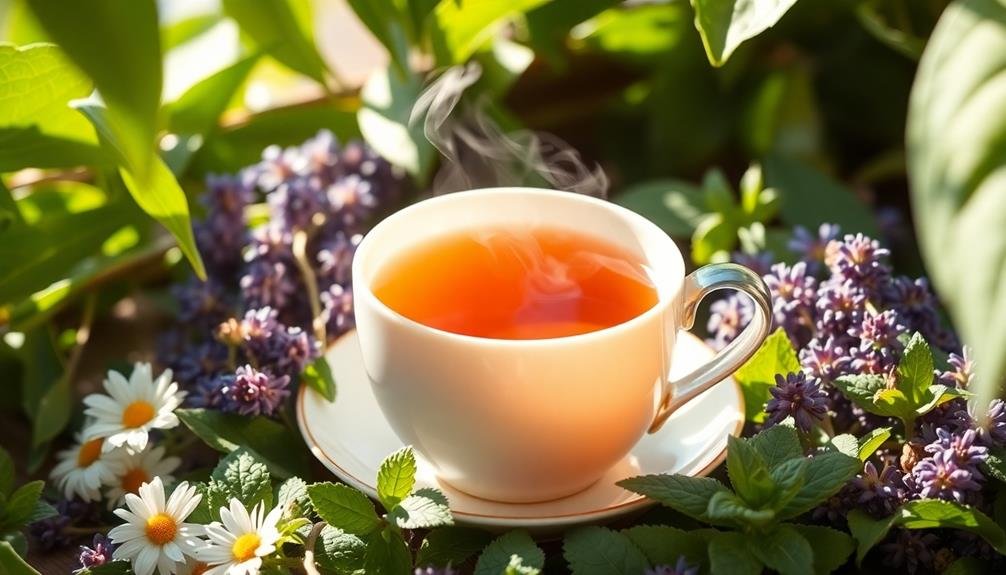
Have you ever wondered why herbal tea has become a staple in so many households? The benefits of herbal tea are hard to ignore.
First, it's packed with antioxidants that help combat free radicals in your body. This can lead to better overall health and a stronger immune system. You'll also find that many herbal teas can aid digestion, making them a perfect after-meal drink.
Another great benefit is that herbal tea can be caffeine-free, allowing you to enjoy a warm cup without the jitters that often accompany traditional tea or coffee. This makes it a fantastic choice for winding down in the evening.
Additionally, herbal teas are incredibly versatile. You can explore different flavors and blends to suit your mood or needs, whether you're looking for a revitalizing mint or a soothing chamomile.
Lastly, many people find that sipping herbal tea can be a calming ritual, promoting mindfulness and relaxation in your daily routine.
Essential Herbs for Stress Relief
Many people regularly turn to herbal remedies for stress relief, and several essential herbs stand out for their calming properties.
If you're looking to soothe your mind and body, consider incorporating these four herbs into your herbal tea routine:
- Chamomile: Known for its gentle calming effects, chamomile helps reduce anxiety and promotes better sleep, making it a favorite for winding down after a long day.
- Lavender: This aromatic herb not only smells wonderful but also has natural soothing properties. Lavender can help alleviate stress and create a sense of tranquility.
- Lemon Balm: With its invigorating citrus scent, lemon balm is recognized for its ability to lift your mood and ease tension, making it an excellent addition to your tea blend.
- Passionflower: Often used for its mild sedative effects, passionflower can reduce feelings of restlessness and promote relaxation, helping you to unwind.
Blending Basics for Beginners
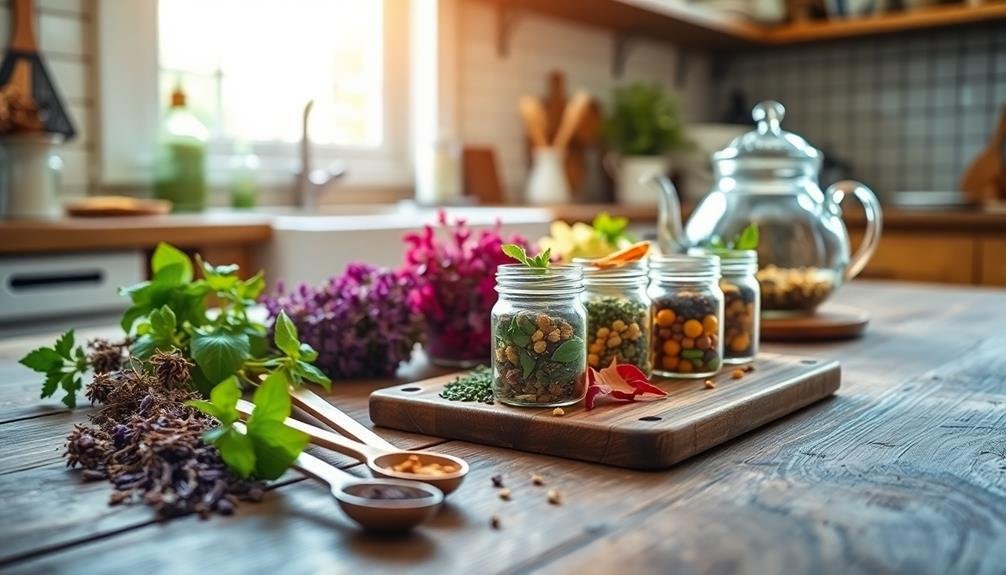
When starting your journey into herbal tea blending, you'll often find that understanding the basics can make a significant difference in your experience. First, familiarize yourself with various herbs and their properties. Each herb brings unique flavors and benefits, so knowing what you're working with is vital.
Next, consider the types of herbs you want to use. Common categories include calming herbs like chamomile, invigorating herbs like peppermint, and aromatic herbs like lavender. It's important to balance these categories to create a well-rounded blend.
Don't forget to experiment! Start with small amounts and adjust based on your preferences. Keep notes on what you like and what you'd change for future blends.
You should also pay attention to the preparation methods. Different herbs might require different steeping times or temperatures.
Lastly, trust your palate. If a blend doesn't taste right, don't hesitate to modify it or try something new. Blending herbal teas is a personal experience, and your preferences should guide your creations.
Enjoy the process and let your creativity flourish as you craft your stress-busting blends!
Perfect Ratios for Calmness
Finding the perfect ratios for calmness in your herbal tea blends can transform your relaxation routine. When you blend herbs, the right proportions can enhance the soothing effects, making your tea a go-to remedy for stress.
Here are four calming combinations to try:
- Chamomile (2 parts): Renowned for its calming properties, chamomile is a must-have in any relaxation blend.
- Lavender (1 part): A little goes a long way; this fragrant herb not only smells divine but also promotes tranquility.
- Lemon Balm (1 part): Known for reducing anxiety, lemon balm adds a rejuvenating note to your tea.
- Peppermint (1 part): This invigorating herb balances the blend, providing a touch of zest while still being calming.
Experimenting with these ratios can help you find your perfect blend. Start with the recommended proportions and tweak them based on your taste preferences.
Techniques for Effective Brewing
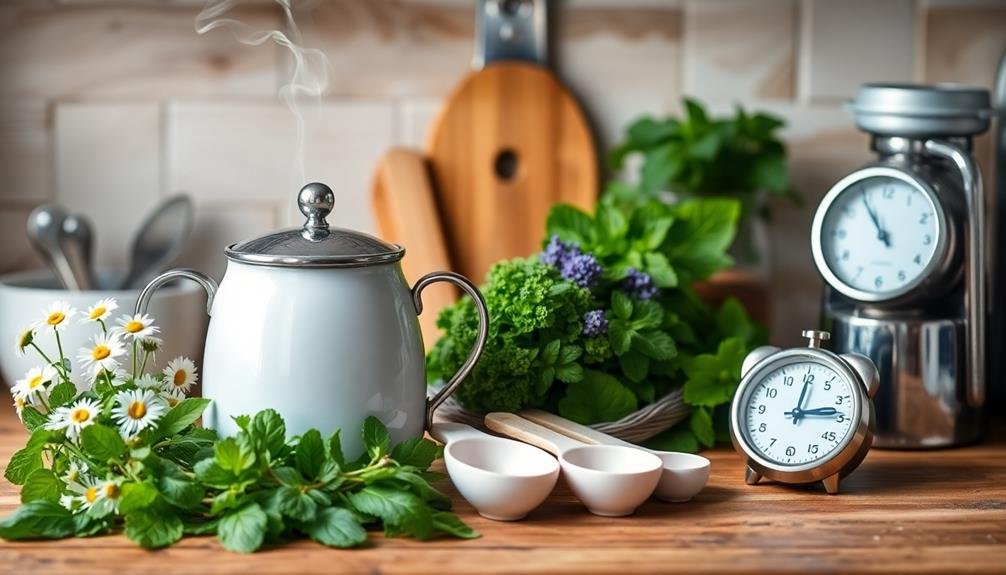
Perfecting your herbal tea blends is just the beginning; the brewing process plays an essential role in releasing the full potential of those ingredients. To brew effectively, pay attention to water temperature, steeping time, and the right proportions.
Here's a quick reference table to help you out:
| Herb | Ideal Brewing Time & Temperature |
|---|---|
| Chamomile | 5 minutes at 200°F (93°C) |
| Lavender | 4-5 minutes at 200°F (93°C) |
| Peppermint | 5-7 minutes at 190°F (88°C) |
| Lemon Balm | 5-10 minutes at 200°F (93°C) |
Using freshly boiled water guarantees you extract the most flavors and benefits. Remember to cover your tea while it steeps; this keeps the essential oils from escaping. After brewing, strain the tea and enjoy it as is, or with a touch of honey or lemon. The right brewing techniques can transform your stress-busting blends into a soothing ritual, allowing you to unwind and savor your creation.
Customizing Your Tea Blends
When customizing your tea blends, start by choosing the right herbs that resonate with your taste and desired benefits.
You'll want to balance flavors and potency to create a harmonious cup.
Don't hesitate to experiment with ratios to find the perfect mix that suits you best.
Choosing the Right Herbs
Choosing the right herbs for your tea blends can elevate your experience, as each herb brings its own unique flavor and health benefits.
To create a personalized blend that suits your taste and needs, consider these key factors:
- Flavor Profile: Think about whether you prefer floral, earthy, or spicy notes. Herbs like chamomile offer sweetness, while ginger adds a zing.
- Health Benefits: Research each herb's properties. For instance, peppermint is great for digestion, while lemon balm can help reduce anxiety.
- Aroma: The scent of your tea is just as important. Herbs like lavender provide a calming aroma, enhancing your overall experience.
- Synergy: Some herbs work better together. Combining herbs like ashwagandha with hibiscus not only balances flavors but also maximizes health benefits.
Balancing Flavors and Potency
Striking the right balance between flavors and potency is vital for creating a tea blend that truly resonates with your palate. When customizing your herbal tea, you'll want to take into account both the taste and the therapeutic effects of the ingredients.
Start by selecting a base herb that offers a pleasant flavor and a calming effect, such as chamomile or lemon balm.
Next, think about complementary herbs that enhance both flavor and potency. For instance, adding a hint of peppermint can uplift the overall experience while providing digestive support. However, be careful not to overpower the blend; too much can mask the subtler flavors.
It's also important to balance the potency of the herbs. If you're using stronger herbs like valerian or passionflower for their calming properties, pair them with lighter, more aromatic herbs to create a harmonious blend.
Taste as you go! This way, you'll guarantee the flavors meld well together and maintain the desired level of effectiveness.
Experimenting With Ratios
Experiment with different ratios to find the perfect blend that suits your taste and needs. Customizing your herbal tea can be a fun and rewarding experience, allowing you to explore various flavor profiles and benefits.
Here are four simple steps to guide you in experimenting with your tea blends:
- Choose Your Base: Start with a primary herb that resonates with you. Popular choices include chamomile for relaxation or peppermint for a revitalizing twist.
- Add Complementary Herbs: Select one or two herbs that complement your base. For instance, try adding lavender for a floral note or lemon balm for a citrusy touch.
- Balance Potency: Adjust the amounts based on your desired strength. If you prefer a milder flavor, use less of the stronger herbs, and vice versa for a bolder taste.
- Taste Test: Brew a small batch of your blend, let it steep, and taste it. Don't hesitate to tweak the ratios until you find the ideal mix that brings you the most satisfaction.
With these steps, you'll create a personalized tea experience that not only tastes great but also supports your well-being.
Happy brewing!
Storing Your Herbal Blends
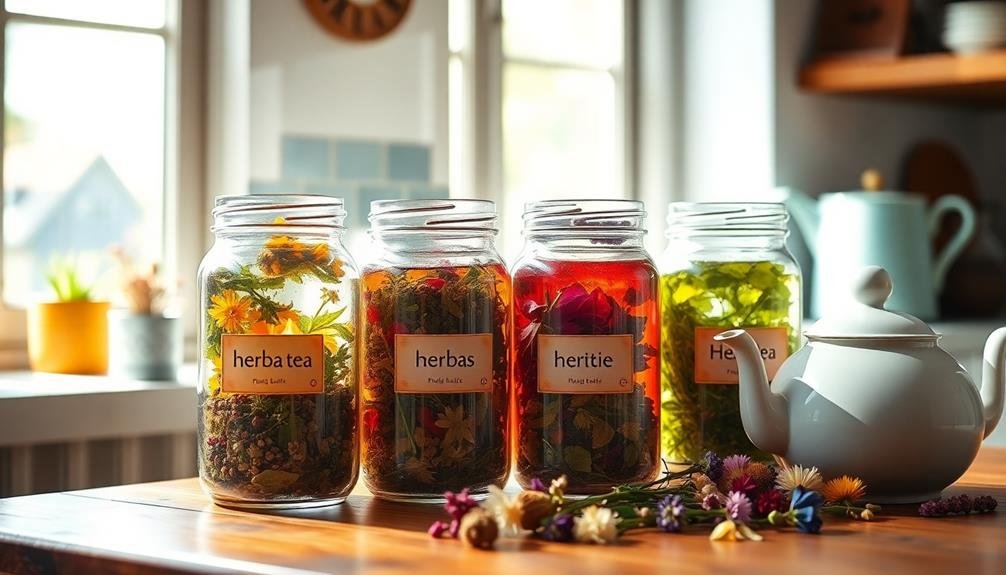
To keep your herbal blends fresh and flavorful, it's essential to choose the right storage containers.
You'll want to maintain ideal temperature conditions to prolong their shelf life.
Let's explore some effective tips for storing your herbal tea blends.
Optimal Storage Containers
When it comes to storing your herbal tea blends, choosing the right containers can make all the difference. Proper storage not only preserves the flavors and aromas but also extends the shelf life of your blends.
Here are some great options to keep in mind:
- Glass Jars: Clear or amber glass jars are excellent for visibility and protection against light. They're airtight and won't react with your herbs.
- Metal Tins: These are sturdy and light-blocking, perfect for keeping your blends fresh. Choose tins with a tight-sealing lid to maintain ideal freshness.
- Ceramic Containers: They offer a stylish touch while being non-reactive. Look for ones with a lid to keep out moisture and dust.
- Plastic Containers: If you're on a budget, BPA-free plastic containers can work, but make sure they're opaque to block light and have a secure lid.
Ideal Temperature Conditions
The right temperature is vital for preserving the quality of your herbal tea blends. When storing your blends, keep them in a cool, dark place, ideally between 60°F and 75°F (15°C to 24°C). Excessive heat can degrade the delicate flavors and aromas you love.
Avoid placing your tea near heat sources like stoves, ovens, or direct sunlight, as these can raise the temperature and compromise your blends.
Humidity is another factor to take into account. High humidity can lead to mold growth or spoilage, so it's essential to store your herbal blends in a dry environment. If you live in a humid area, think about using desiccants or moisture-absorbing packets in your storage containers to help keep moisture at bay.
You should also keep your blends away from strong odors, as they can easily permeate and alter the taste of your tea. Stick to airtight containers, and avoid transferring your blends in and out of different environments frequently, as this can create condensation that affects quality.
Shelf Life Tips
Properly storing your herbal blends can greatly extend their shelf life and maintain their flavor. To keep your teas fresh and aromatic, follow these essential tips:
- Use Airtight Containers: Opt for glass or metal containers with tight seals. This prevents moisture and air from degrading your blends.
- Store in a Cool, Dark Place: Find a pantry or cupboard away from direct sunlight and heat sources. Excess heat and light can diminish the quality of your herbs.
- Keep Away from Strong Odors: Herbal blends can easily absorb surrounding smells. Store them away from spices or other strong-scented items to preserve their unique flavors.
- Label and Date Your Blends: Always label your containers with the blend name and the date you made it. This helps you keep track of freshness and guarantees you use them in a timely manner.
Tips for Enjoying Herbal Tea
Enjoying herbal tea can be a delightful experience that engages your senses and promotes relaxation. To make the most of your tea time, start by selecting a blend that speaks to you. Think about the flavors you love and the benefits you seek, whether it's calming chamomile or invigorating peppermint.
Next, pay attention to the water temperature. Different herbs release their flavors best at specific temperatures, so follow the guidelines for your chosen blend. Generally, 200°F is ideal for most herbal teas. Steep your tea for the recommended time—typically 5 to 10 minutes—to fully extract the flavors.
Consider enhancing your experience with mindful sipping. Find a cozy spot, breathe in the aroma, and take slow, deliberate sips. You might also want to personalize your tea with natural sweeteners like honey or a splash of lemon, but remember to keep it balanced.
Lastly, make it a ritual. Set aside time to enjoy your tea without distractions. This not only makes your experience more enjoyable but also helps you unwind and appreciate the moment.
Immerse yourself in your herbal tea journey, and relish the tranquility it brings!
Frequently Asked Questions
Can Herbal Tea Replace Prescription Medications for Stress Relief?
Herbal tea can be a helpful tool for stress relief, but it shouldn't replace prescription medications without consulting a healthcare professional. You should explore both options to find what works best for your needs.
Are There Any Side Effects of Drinking Herbal Tea Daily?
Drinking herbal tea daily can lead to minor side effects like digestive issues or allergic reactions. You should pay attention to your body's responses and consult a healthcare professional if you notice anything unusual.
How Long Does the Calming Effect of Herbal Tea Last?
The calming effect of herbal tea typically lasts for about two to four hours, depending on the blend and your body's response. You might find it helpful to sip periodically for sustained relaxation throughout the day.
Can I Mix Herbal Teas With Other Beverages Like Coffee?
Yes, you can mix herbal teas with other beverages like coffee! Just remember to balance the flavors, as some herbal teas might overwhelm the coffee's taste. Experiment to find a blend you enjoy!
What Is the Best Time of Day to Drink Stress-Relief Herbal Tea?
The best time for you to drink stress-relief herbal tea is in the evening. It helps you unwind after a long day, promoting relaxation and better sleep, so you wake up refreshed and ready.
In Summary
Incorporating stress-busting herbal tea blends into your daily routine can truly make a difference. By understanding the essential herbs and perfect ratios, you can create a calming brew tailored to your taste. Don't forget to explore different blending techniques and storage methods to keep your teas fresh. Enjoy each sip mindfully, and let the soothing flavors wash over you. With a little practice, you'll have your go-to blends ready whenever you need a moment of peace.

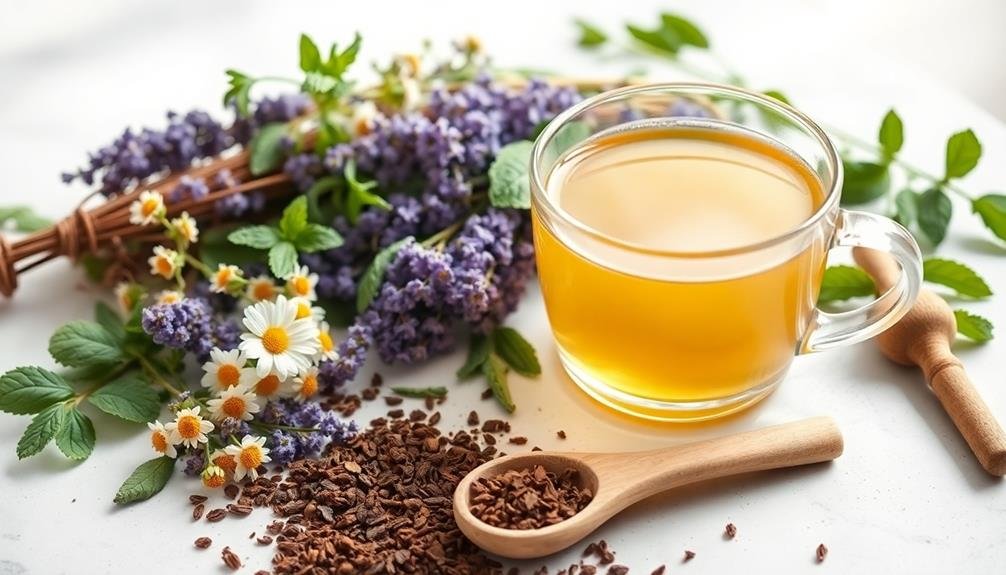
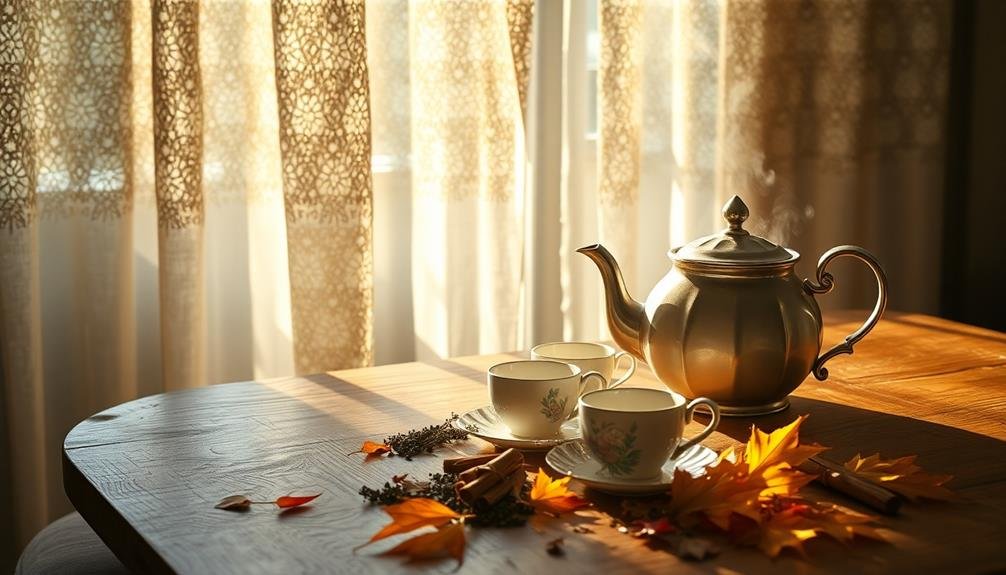
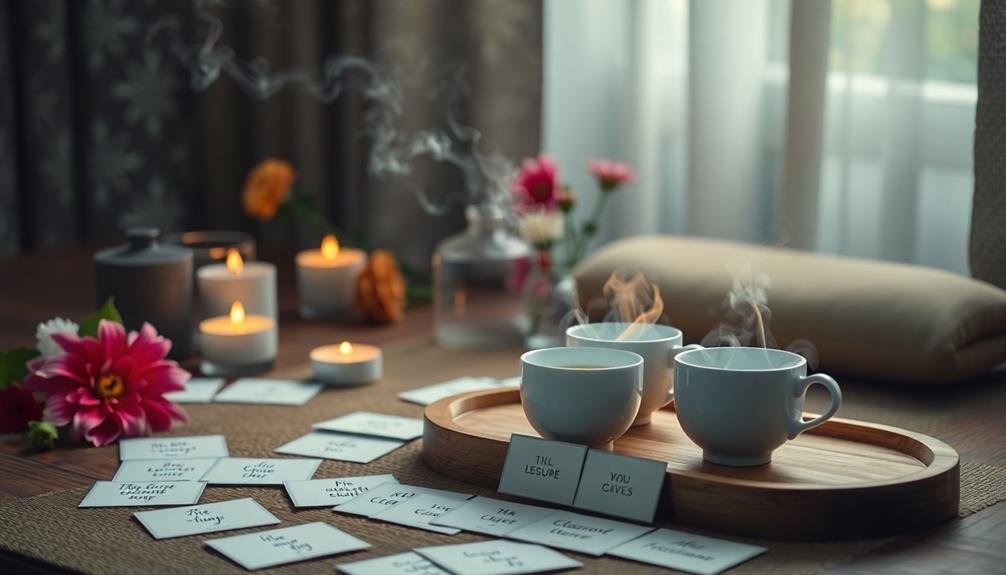
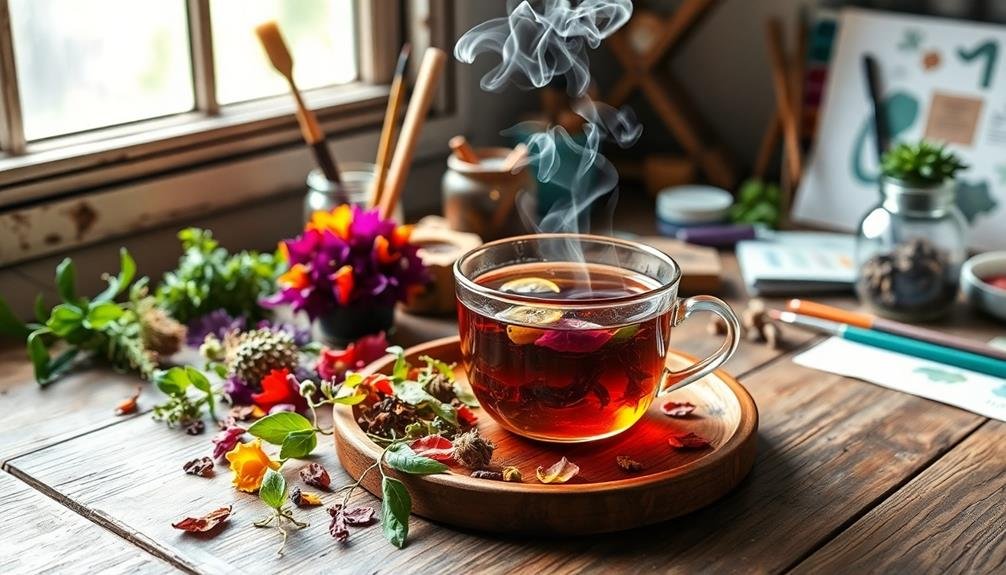
Leave a Reply